Hiking destinations in Norway
Norway is mostly wilderness and all is accessible for hikers. There is an abundance of hiking options throughout the country. The most attractive hiking destinations are above the tree line (about half of Norway's total area), but hiking is also a popular activity in the lowlands and within cities like Oslo. During winter the same trails and areas are used for cross country skiing in groomed tracks (typically near cities or resorts) or as ski touring.
Special rules apply to Svalbard and the archipelago is not covered in this article.
Understand
- See also: Hiking in the Nordic countries, Right to access
The freedom to roam allows you to go more or less anywhere. The best hiking or scenery is not necessarily in national parks or nature reserves; you can find very nice landscapes and routes also in unprotected wilderness. Those who like wilderness backpacking or want to be off roads for several days might look for the least populated areas.
The Trekking association (DNT) maintains trails between their many huts (mountain lodges) in all parts of the country. National parks are often surrounded by a zone of "protected landscape", which from the hiker's point of view often is the most interesting and usually the most accessible wilderness.
There are several types of protected area, some with severe restrictions, some mostly irrelevant for the hiker. The different types can be intermingled with each other.
Unlike in many other mountain areas, the tree line in Norway (and the rest of the Nordic countries) is made of small birch – fell birch – and other low bushes. Pine and spruce have a lower altitude limit. The wide spruce and pine forests in East Norway, and in border regions of Middle and Northern Norway are the western end of the great Eurasian taiga belt.
Many areas of Norway's high mountains are covered by stone runs or blockfields, that appear as "oceans" of rocks and boulders. Unlike screes that accumulate at the base of crags or cliffs, stone runs occur on flat or gently sloping terrain. This phenomenon is common for instance in Dovre, Rondane, Jotunheimen and Sunnmøre-Romsdal mountains, and is presumably caused by myriad freezing-thawing cycles in prehistory.
Climate
Norway is a wide and varied country with different climates. Complicated topography, an immense coastline, mountains, the warm Gulf stream and other factors create surprising variations across short distances.
- Temperature is roughly determined by three factors: Proximity to the ocean (areas closer to the Atlantic has milder winters and cooler summers, and longer hiking season), altitude (higher areas have shorter summer season and temperatures drop notably with altitude also in summer), latitude (shorter summer season and lower temperatures further north). This means that the mildest climate is in the south-west corner at low altitude (around Bergen or Stavanger), while the coldest winters are in the northern interior in Finnmark (the interior of East Norway around Røros, Tynset, Lom and Gudbrandsdalen also have low temperatures in winter).
- Precipitation is highest on the western slopes facing the Atlantic (where mountains lift humid air coming in from the ocean), while the driest areas are in the rain shadow created by high mountains and glaciers (notably just east of the watershed in the central mountains such as Jotunheimen summits). This means that the interior of east Norway and north Norway are relatively dry, in fact areas in the Finnmark plateau, Troms interior valleys and east Norway interior are among the driest in Europe. Fog is common at high altitudes and on the western slopes.
- Weather is most windy and most unpredictable along the coast and in the high and/or exposed mountains. Visitors should not underestimate how fast wind can occur and the difficulties wind can cause.
Destinations
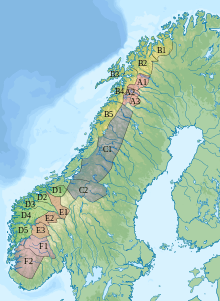
The list below distinguishes hiking areas by dominant terrain features. There is no sharp distinction between between these types of landscapes, but for the visitors, it is worth noting, as for instance the most alpine mountains can be challenging. In Norwegian, "mountain" ("fjell") mostly refers to elevations reaching above the tree line. Less steep, relatively level, treeless plateaus without pronounced peaks are often called "vidde". These high mountains and plateaus are a kind of alpine tundra, but note that Norwegians don't use the word "tundra" to describe such landscapes. Instead in Norwegian such landscape are referred to as barren mountains or fell ("snaufjell"), about half of mainland Norway is this type of landscape.
High alpine mountains

High alpine mountains include areas with distinct peaks, ridges, lakes and glaciers resembling the Central European Alps. Some of these summits are accessible for skilled climbers only, but mostly even the wildest peaks can be conquered by experienced hikers.
- B2: Troms mountains including Lyngen alps and Senja island. This is a large and varied area from the wide forest valleys of the interior via the steep summits of Lyngen to the lovely sandy beaches of Senja. Senja is Norway's second largest island and offers all kinds of nature such as white sandy (albeit cool) beaches, incredible jagged summits ("devil's jaws") right on the Atlantic and bogs and pine forest in the sheltered areas.
- B3: Lofoten and Vesterålen. The extraordinary "alps" of these islands rise directly from the Atlantic, in particular Lofoten mountains appears as a wall ("the Lofoten Wall") when seen from a distance. Largely moderate altitudes (500 to 1000 meters), but many steep and demanding ascents.
- Himmeltindan (931 meters) easy hike, about 5 hours, great panorama from summit.
- Møysalen (1262 meters) is a demanding yet rewarding hike, 10 hours, difficult, for experienced hikers and good weather only.
- B4: Tysfjord, Narvik including Rago and Sjunkhatten national parks. Summits such as the iconic Stetind are for skilled climbers only.
- B5: Svartisen glacier, Saltfjellet plateau, and surroundings. Okstindene alps (1562 to 1916 meters) are the highest mountains in Northern Norway.
- D2: Romsdal alps these are the wild alpine mountains surrounding Eikesdalen valley, the magnificent Romsdalen valley and Trollstigen mountain pass. Partly protected as national park that also includes nearby Tafjord mountains. The area include some of the tallest waterfalls and one of the tallest rock faces in the world. Along with Jotunheimen this is a centre for mountain climbing in Norway.
- Lauparen (1470 meters) unknown except by locals, airy and great panorama from summit.
- Romsdalseggen (hike near Åndalsnes) excellent panorama of the local alps and fjords.
- D3: Sunnmøre alps and Tafjord mountains. The Sunnmøre alps are the steep summits that surround the magnificent Hjørundfjord in Stranda, Sykkylven and Ørsta districts, these "alps" rise directly from the fjord and overlook the Atlantic. Notable summits include Slogen (1564 meters, somewhat demanding) and Liadalsnipa (924 meters, short and airy). Further east are the slightly more rounded mountains and deep valleys around Geiranger, Valldal and Tafjord - the Tafjord mountains is a popular area for hikes of two to four days, lodgings provided by the Trekking association (DNT). The Tafjord mountains are partly protected as national park and to the east/south-east the terrain changes into plateau landscape with wide valleys and gentle mountains. Wild reindeer roam the eastern areas.
- D4: Jostedalsbreen and surrounding glacier area. Includes mainland Europe's largest glacier (that sits on a high plateau) and some smaller plateau-glaciers to the east (near Jotunheimen) and to the west. The western glaciers are maintained by heavy snowfalls. Hiking on glaciers can only be done with a skilled guide and appropriate equipment, but there is a great variety of demanding and rewarding hikes outside the very glaciers – often with great views of glaciers. The area is characterized by extremes and variation, from the lovely fjords and fertile valleys mountains rise abruptly to summits and glaciers. There are several trailheads for long treks in the secluded Jostedalen valley.
- Skålatårnet summit (1843 meters) with the landmark lodge is one popular but demanding hike, trailhead at Loen village (sea level).
- Guided glaciers hike are available at Olden (Briksdalen glacier) and Jostedalen (Nigardsbreen glacier).
- E2: Jotunheimen are the highest mountains in Northern Europe and Norway's most famous mountain area, most of which is protected as a national park. Although the range includes some of the wildest alpine areas in Norway and a few summits are only accessible by climbers, most of the area can easily be hiked by most visitors with proper boots and fitness.
- The Besseggen ridge is one of Norway's most popular hikes, this characteristic ridge is also featured in Ibsen's dramatic poem Peer Gynt, at least 6 hours hike for the average adult (proper boots needed).
- Galdhøpiggen (2469 meters) is the highest summit in Scandinavia and is visited by thousands every summer. Trailhead at Juvasshytta (1800 meters), 3–4 hours hike to summit, guided is needed as the trail crosses a glacier. Available for families, proper boots needed.
- Utladalen valley is one of the deepest in Europe as it cuts deep between Hurrungane group (western Jotunheimen) and central Jotunheim. The valley is some 20 km long and offers access to Jotunheimen from Årdal village. The valley floor is at low altitude and offers pleasant walk among steep yet fertile hills. Vettisfossen waterfall is almost 300 meters tall.
- Fannaråken (2068 meters) highest lodge in Norway.
- Kyrkja ("the Church", 2032 m) a distinct summit with excellent panorama, 6 hours intermediate difficulty, scramble to summit for experienced hikers (inexperienced hikers must go with a guide).
Other mountains
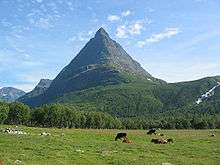

The other mountains often have pronounced summits, but they are more rounded, less wild and ascent is easier than in the high alpine mountains. In eastern Norway, valleys are often wider or are basically plateaus that summits rise above, while in the west and north valleys can be narrow and steep even if plateau above is largely flat.
- B1: Kvænangen and islands in Western Finnmark. Fragmented landscape with fjords, glaciers and some distinct peaks directly at the Atlantic. Seiland national park
- C2: Sylane in Middle Norway.
- Storsylen (1762 meters) a fine summit in Trøndelag near border with Sweden. Easy but a long hike, about 9 hours.
- D4: Lowlands and moderate altitudes around Naustdal, Førde, Fjaler and Gaular has a varied terrain, easy access for family-friendly hikes. Fertile landscape with lots of red deer, proximity to the Atlantic makes weather humid and unstable. Countless lakes, streams and waterfalls. This is the kingdom of the red deer.
- D5: Stølsheimen and Voss mountains. Rugged mountains, partly alpine. Extensive hydro electric power production in the western parts.
- E3: The Skarvheimen includeds Hallingskarvet ridge, Hemsedal mountains and rounded mountains between Hardangervidda (Bergen railway) and Jotunheimen (road E16). The mountain passes on roads 52 and 50 runs through the area. This area is well suited for ski touring. Around Flåm, Aurland and Lærdal deep valleys cut into the plateau.
- Aurlandsdalen is a deep and wild valley running from sea level at Aurland to the barren uplands. The lower part is a fertile gorge with the giant's cauldron (aptly named "small hell") and a variety of waterfalls. Easy access and easy navigation. Upper part available by road 50. Excellent for short family-friendly hikes, or multiday hikes between sea level and Bergen railway on the high plateau.
- D5: Bergen mountains. The city of Bergen is dominated by several relatively steep mountains. These allow easy day hikes or full day hikes, trailhead downtown or at bus stops. A cable car and a funicular lifts passengers passed the steepest hills for two of these "city mountains". Summits between 600 and 900 meters altitude. Excellent panorama towards myriad of islands and the Atlantic beyond.
- D1: Trollheimen is the mountain range between roads 70, 65 and E6. Fertile, sheltered valleys, countless lakes and handful monumental alpine summits is typical for this area which is the home turf of Trondheim Trekking association (a branch of DNT). Lodging provided in picturesque cottages. Lovely Innerdalen (claims to be Norway's prettiest) near Sunndalsøra is a popular starting point.
- E1: Rondane-Dovrefjell is partly high plateau, partly high slightly rounded summits in one of Norway's driest areas. Includes several national parks and is a habitat for wild reindeer. On the western edge of the area (towards Eikesdalen, Romsdalen and Sunndalen) the landscape becomes wilder and more alpine.
- The Snøhetta summit (2286 meters) is a landmark on the Dovre plateau and was long believed to be Norway's highest, in fact the highest summit outside the Jotunheimen range. A 5-6 hour hike to summit. Often foggy.
- Rondslottet summit (2178) a fine summit with wide panorama of Rondane massif.
- Veslesmeden summit (2015 m) is one of the finest summits in Rondane. Intermediate difficulty, but some boulders, 6 hours.
- Mount Gausta (1880 meters) at Rjukan (just south of Hardangervidda) is one of Norway's most distinct and majestic summits and supposedly the one the gives the widest panorama. About 5 hours hike, easy. This is also one of Norway's most visited summits. The Norwegian triathlon has Gausta as the end point for the marathon section of the race.
High plateaus and moorland
Typical for Norway are steep fjords and valleys that suddenly give way to a high, more or less even plateau. These plateaus are often referred to as "vidde" meaning a wide, open treeless space, a boundless expanse. In Rogaland and Agder they are usually called "hei" meaning a treeless moorland often covered in heather. Such high plateaus are usually regarded as mountains even if there are no pronounced peaks. The high barren plateaus is a key habitat for wild reindeer, while in northern Norway the plateaus are used for domesticated reindeer.

- Finnmark plateau. Finnmark is largely a wide plateau at about 300 to 700 meters above sea level, cut through by wide fjords, valleys and rivers. The largest area is Finnmarksvidda (about the size of Belgium) at about 300 to 500 meters altitude in the interior of Finnmark, partly barren mountains and partly low birch-bushes, bogs and lakes, relatively flat, in winter this is the coldest area in Norway, with extensive reindeer herding. Topographically Finnmarksvidda continues into Finland. The wide fjords of Finnmark create large peninsulas, notably the Varanger peninsula (partly national park). Stabbursdalen at Lakselv is also protected as a national park. There is only a limited number of lodges and marked trails. Finnmark county has Norway's largest areas unaffected by infrastructures such as roads and power lines. The area is used as pastures for semi-domesticated reindeer, so the reindeer herds there are privatly owned.
- F1: Hardangervidda plateau is one of the most popular hiking areas, easily accessible by train (Bergen line) or road. Mostly gentle tundra at 1000 meters or more above sea level, some pronounced summits and a notable glacier in the north-west corner rise above the plateau. Trails and lodges maintained and operated by the Trekking association. This is the land of the wild reindeer.
- Trolltunga, an unusual cliff, at the edge of Hardangervidda (access from Odda/Tyssedal) has become a very popular hike. Warning: The hike is long and strenous and ascends into the high barren plateau. This is only for fit and experienced hikers with proper gear. Snow often remains into mid summer, and the hike can not be done in spring even if days are long and weather is fine. A long hike like this can not be done in autumn when days are getting short. There has been fatal accidents and numerous rescue operations. Visitors that are unsure should cancel or go with a local guide. Season: July through September.
- Norefjell and Eggedal hills/mountains climbs from forests to barren plateaus at the edge of Hardangervidda.
- F2: Rogaland, Setesdal and Telemark/Agder moorland. In the western part (Ryfylkeheiene) this area also cover some wild fjords that cut deep into the plateaus, including the impressive Lysefjorden with the iconic Pulpit rock (Preikestolen). The eastern (Austheiene) and central part stretches from forested hills at 500–800 meters to barren mountains at 1500 meters in the northern corner. Relatively long summer season at intermediate altitudes.
Forests and lowland
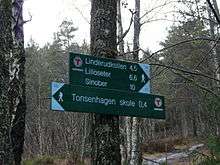
The forest and lowland landscapes include deep pine or spruce forests as well as birch. Terrain can be rugged and difficult to navigate. Bogs, lakes and calm rivers are common. This is the preferred habitat for moose ("elg"), Norway's biggest animal. The wide spruce and pine forests of East Norway is the westernmost corner of the Eurasian taiga belt that covers large parts of Sweden, Finland and Northern Russia.
- Femundsmarka - the wide forests surrounding the Femunden lake, Norway's third largest. The area is partly in Sør-Trøndelag and partly in Hedmark county.
- Uplands between Østerdalen and Gudbrandsdalen valleys. The Dovre-Rondane range gradually transforms into a gentle plateau, forests and finally becomes the Hedmark flatlands at Hamar. In the northern part there are barren summits at over 1000 meters, but mostly bogs, grassland, forests and lakes. Excellent for day hikes, cycling also possible on tractor roads.
- Trondheim forest are the forested hills, bogs and low mountains (up to 500-700 meters) surrounding the city of Trondheim. The area includes parts of Klæbu, Melhus, Støren and Malvik districts, small parts are protected as nature reserves. The forested hills just west of downtown Trondheim (Bymarka) is the most accessible and includes a total of 300 km trails, in winter 120 km groomed tracks and 50 km with lights.
- Oslo forest - also known as Oslomarka. A large number of lakes, small rivers, rugged hills and tiny summits up to 600 meters above sea. This is the most accessible of all hiking destinations in Norway about 15 minutes by public transport from central Oslo. Metro (t-bane), buses and trams run to the edge of the forest (partly into the forest). A fine network of trails. Many trails are well groomed and key trails are available with wheelchair and baby stroller, key trails have lights until 23 (11 pm) in the evening. Trails in the Oslo forest are used for cross-country skiing in winter.
- The "Jotunheimen trail" (Jotunheimstien) is a largely continuous trail from downtown Oslo through Oslomarka and lowlands/forests further north and into the uplands between Gudbrandsdalen and Jotunheimen until Gjendesheim. There are 16 lodges (hytter) along the trail. 320 km and estimated 17 to 20 days hike.
- The "Rondane trail" (Rondanestien) also begins downtown Oslo at sea level and runs through the forested hills north of Oslo, through the lowlands near the airport, runs through the forest east of Mjøsa lake and east of Gudbrandsdalen. The northernmost part runs through Rondane proper and ends at Hjerkinn railway station and junction on the Dovrefjell plateau. About 400 km, 12-15 days.
- Drammen forest and Finnemarka. Typical modest east Norway landscape covered by large spruce and pine, bogs and lakes are common, small hilltops provide panorama. Cycling, skiing and bathing in addition to hiking. Finnemarka ("Finnish forest") owes its name from Finnish immigration and settlement in the 17th century.
- Skrim forest and hills between Kongsberg and Skien is a relatively small but varied area, mostly low altitude forest but a few summits above the treeline. A handful of unmanned lodges (DNT).
- Vassfaret and surroundings is a relatively small area of forest and barren summits between Sperillen lake (road E16) and Hallingdal (road 7). The Vassfaret valley once had the last significant brown bear population in South Norway, now a few individual bears live there. The southern end of this forest area stretches through the village of Sokna almost to Tyrifjorden lake. Partly protected landscape. A handful of unmanned lodges (DNT).
- Pasvik valley in Finnmark county is a wide almost flat, forested valley between Kirkenes and Enare lake in Finland. This the northeastern corner of the great Eurasian taiga has countless bogs and shallow lakes. The area gets very little precipitation and is relatively warm in summer. The valley is partly protected as a national park and is home to Norway's greatest concentration of brown bear and a number of rare species are also found in these forests. This is an ancient woodland basically untouched by humans. In the far end of the area the borders of Norway, Finland and Russia meet (walking on the Russian side is illegal), at this tripoint three time zones also meet.
Outer coast and islands
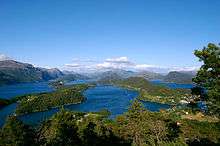

Norway's coast line is very long and extremely fragmented, and in addition to fjords and bays there are several hundred thousand islands. Some of these are islands are large and with significant alpine mountain ranges, such as Lofoten and Senja (see separate section). More modest elevations yet rugged landscape are found all along the coast. The coastal stretch from Kristiansand to Lofoten enjoys a mild climate, weather is however unpredictable: wind, waves and showers can occur at any time.
- Helgeland coast is the 200 km coastal section of Nordland county south of Svartisen glacier. This is the land of thousand islands and million birds. There are about 10.000 islands of all sorts. Sandy beaches and incredible summits makes Helgeland one of the most picturesque areas in Norway, but often skipped by foreign visitors rushing between fjords and Lofoten. The Vega islands was included in the UNESCO world heritage list in 2004. Hikes are often short (1 hour or short day) but rewarding, particularly on the islands. Kayak is great way to get around the shallow waters. Do not disturb the common eider during breeding season.
- Landmarks such as Torghatten and Seven sisters are popular hikes.
- Nordmøre islands with Hitra island. Marked trails and some lodges in Tustna, Ertsvågøya and Aure just north of Kristiansund.
- Nordhordaland and Sotra islands is the area north and west of Bergen. Very fragmented landscape where the distinction between mainland, peninsulas and islands is not clear. Countless straits, bays and small lakes. It's a relatively built up area and modest altitudes such that hikes are relatively short but rewarding. Unpredictable but mild climate allowing hiking most of the year.
Sleep
- See also: Hiking in the Nordic countries#Sleep

By the marked trails there are usually cabins, many of them with food for sale and other service. There are also cabins to rent as a base for hikes in a certain area. Most cabins without personnel are locked with the key of the Trekking association (DNT). The price for sleeping in the unmanned cabins is generally 100–200 kr/night, but can be considerably more. Sleeping in dormitory at manned cabins may be in the same range.
Get in
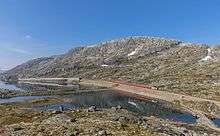
As there is such a wide variety of hiking options, there is no general advice about transport to trailheads except that trailheads are available by car. A self drive offers the easiest access to remote corners, and public transport may be infrequent. Visitors that want to hike across an area must however rely on public transport. Bergen railway, Dovre railway and Nordland railway all run through high plateaus and some stations are also trailheads. Express buses can also be used from cities into the countryside. During the hiking season there are some buses running to trailheads such as Gjendesheim at Jotunheimen. In the fjord and coast region boat may be necessary or convenient access to trailheads. Some hiking areas, notably in Oslo and Bergen, are available by city transport (bus, metro) or trailhead is downtown. The northern part of the country, notably Finnmark, is easiest to reach by plane as surface transport is very time consuming. In general there is no porter service arranging luggage transport to next lodge.
Further reading
The suggestions given in this article are not sufficient to plan and navigate a hike. A topographical map of the area (1:50,000) is needed. Additional reading for each area will also be useful, for instance:
- Per Roger Lauritzen: Huts and hikes in Jotunheimen. Where to go, how to go, where to stay. Published by the Trekking association, 2001
- Ed Webster: Climbing in the magic islands. A climbing & hiking guidebook to the Lofoten islands of Norway Published in Henningsvær, 1994.
- Claus Helberg: Norwegian mountains on foot. A description of marked foot paths in Norway The trekking association, 1996.
- Stig J. Helset, Fredrik Sigurdh and Eirik Vaage: The Sunnmøre Alps. an outdoor guide. Oslo: Fri Flyt publisher, 2012.
- Tony Howard: Walks and climbs in Romsdal, Norway. Written and illustrated by Tony Howard. Manchester : Cicerone Press, 1970.
Free leaflets in English are available from the Trekking association (DNT). DNT has a wide selection of guides in Norwegian.
Hiking as recreation in Norway's mountains and highlands was largely developed by English leisure class. Early books on the topic were first published in English
- William Cecil Slingsby: Norway, the Northern Playground. Sketches of climbing and mountain exploration in Norway between 1872 and 1903. Published in Edinburgh, 1903.
- Walter J. Clutterbuck og James A. Lees: Three in Norway (by two of them) published i London (1882) by Longmans, Green & Co.